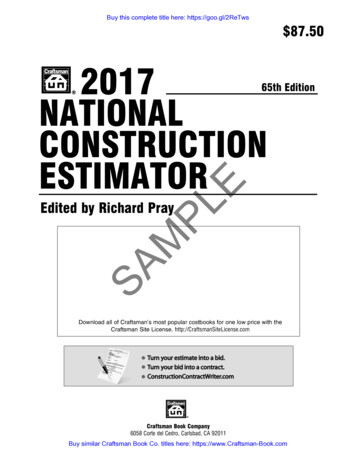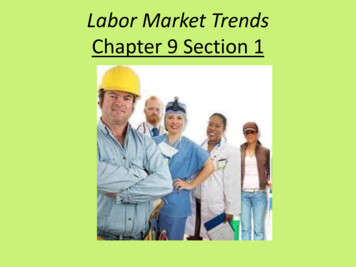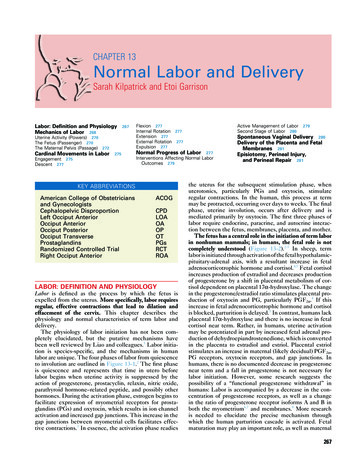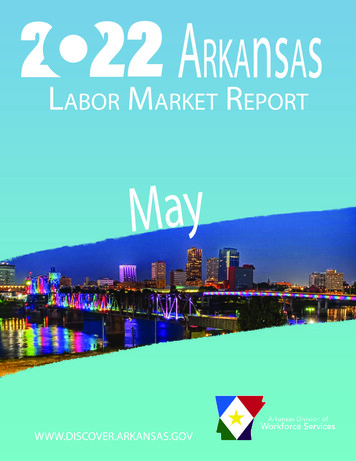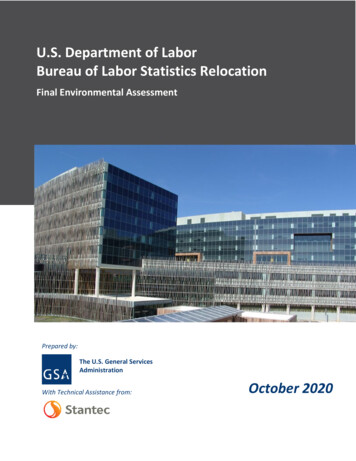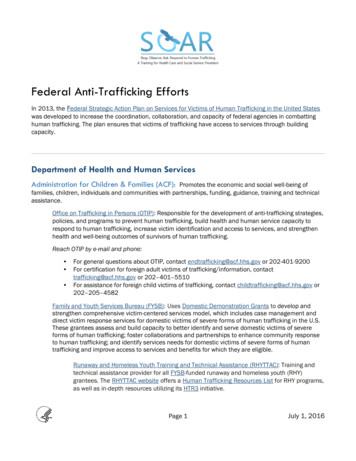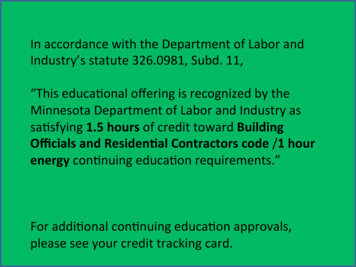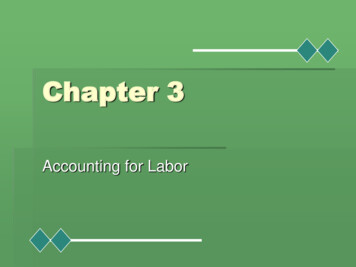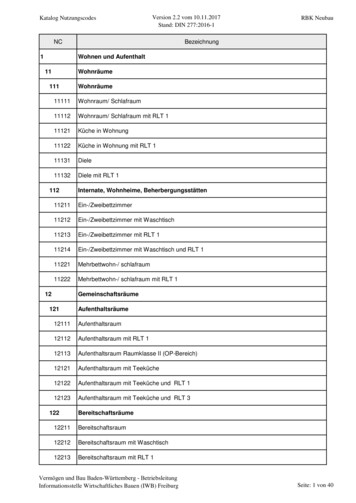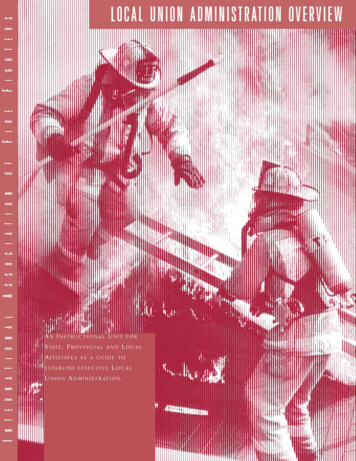
Transcription
U.S. Department of LaborAdministrative Review Board200 Constitution Avenue, N.W.Washington, D.C. 20210In the Matter of:ANTHONY MENENDEZ,ARB CASE NO.12-026ALJ CASE NO.2007-SOX-005COMPLAINANT,v.DATE: March 15, 2013HALLIBURTON, INC.,RESPONDENT.BEFORE:DATE REISSUED: March 20, 2013THE ADMINISTRATIVE REVIEW BOARDAppearances:For the Complainant:Joseph Y. Ahmad, Esq.; Ahmad, Zavitsanos, Anaipakos, Alavi, & Mensing PC,Houston, TexasFor Respondent:W. Carl Jordan, Esq.; Corey E. Devine, Esq.; Vinson & Elkins L.L.P.,Houston, TexasBEFORE: Paul M. Igasaki, Chief Administrative Appeals Judge; E. Cooper Brown,Deputy Chief Administrative Appeals Judge; and Joanne Royce, AdministrativeAppeals JudgeFINAL DECISION AND ORDERAnthony Menendez filed a complaint under Section 806 of the Corporate andCriminal Fraud Accountability Act of 2002, Title VIII of the Sarbanes-Oxley Act (SOX),18 U.S.C.A. § 1514A, on May 8, 2006. Menendez alleged that his employer,USDOL/OALJ REPORTERPAGE 1
Halliburton, Inc. (Respondent or Halliburton), retaliated against him in violation ofSOX’s employee protection provisions after he alerted the SEC and Halliburton’s AuditCommittee to concerns about violations of Generally Accepted Accounting Principles(GAAP) with respect to revenue recognition and joint venture accounting practices.After a three-day hearing, a Department of Labor (DOL) Administrative Law Judge(ALJ) found that Menendez engaged in SOX-protected activity but failed to prove thatHalliburton subjected him to retaliatory adverse action. The ALJ dismissed Menendez’scomplaint.On September 13, 2011, the Administrative Review Board (ARB or Board)reversed the ALJ and remanded the case. We held that Halliburton’s breach ofMenendez’s confidentiality was an adverse action and remanded for a determination ofwhether Menendez’s protected activity was a contributing factor to this adverse actionand, if so, whether Halliburton demonstrated by clear and convincing evidence that itwould have acted adversely in the absence of Menendez’s whistleblowing. On December8, 2011, the ALJ again dismissed Menendez’s complaint finding that Halliburton provedits affirmative defense. The ALJ, however, issued an alternate finding in favor ofMenendez and awarded compensatory damages and attorney fees. We affirm the ALJ’salternate finding in favor of Menendez and reverse the dismissal of his complaint.BACKGROUND1. Factual BackgroundWe include here the same summary of the facts contained in our 2011 Decisionand Order of Remand.Halliburton hired Menendez as Director of Technical Accounting Research &Training in March 2005 to support Halliburton’s Finance and Accounting (F&A)organization.1 His duties included monitoring and researching technical accountingissues and advising and training field accountants. Menendez reported directly to MarkMcCollum, Halliburton’s Chief Accounting Officer (CAO).One of Menendez’s early projects involved variable interest entity (VIE)guidelines contained in Interpretation No. 46 (“FIN 46”) issued by the FinancialAccounting Standards Board (FASB). These guidelines address abuse of off-balancesheet accounting in the wake of Enron. Menendez was asked to review an entity calledGMI, a joint venture set up between Halliburton and other investors to develop1Menendez v. Halliburton, Inc., ALJ No. 2007-SOX-005, slip op. at 3 (Sept. 18, 2008)(Decision and Order (2008 D. & O.)).USDOL/OALJ REPORTERPAGE 2
technology and perform research and development.2 When Menendez reviewed thefinancial statements, he noticed that as the cash went in, it went directly out.3Menendez’s recommendation on GMI was that the entity was valueless and should bewritten off. McCollum and J.R. Sult, former Vice President and Controller forHalliburton’s Energy Services Group,4 agreed, and GMI was ultimately written off.5Menendez also raised specific concerns about Halliburton’s revenue recognitionpractices under Standard Accounting Bulletin (SAB) 104 (realizing earned income) andEmerging Issues Task Force (EITF) 00-21 (multiple deliverables).6 Based on his review,Menendez thought defects in recognition practices could have a major impact onHalliburton’s financial statements, and in June 2005, he approached McCollum to discusshis concerns.7 On July 15, 2005, Menendez circulated a memorandum taking the positionthat Halliburton could not recognize revenue on certain products prior to their deliveryinto the physical possession of the customer.8 Menendez met with McCollum on July 18,2005, to discuss the memo.9 Menendez taped the meeting.10 McCollum told Menendezthat his memo was good but that he was not a team player, was insensitive to politics atHalliburton, and should collaborate more with his colleagues in working on accountingissues.11 Menendez also discussed his revenue recognition concerns with Sult, thenController for the Energy Services Group, and to others who were working on the issue.1222008 D. & O. Evidentiary Appendix (E.A.) at 21 (The Evidentiary Appendix (E.A.)is attached to the ALJ’s Decision and Order, and is treated as part of the Decision and Orderfor purposes of the Board’s review.).3Id. at 22.4Id.5A few weeks later, Menendez and his group researched Fiberspar, another jointventure with Halliburton, and issued a memorandum suggesting that the proper accountingtreatment would require this entity to be written off as well. Fiberspar was written off. E.A.at 23.6E.A. at 24.7Id. at 30, 31.82008 D. & O. at 3; E.A. at 29.9E.A. at 29-30; 2008 D. & O. at 3.10E.A. at 30.11E.A. at 30; 2008 D. & O. at 3, 9.12E.A. at 29.USDOL/OALJ REPORTERPAGE 3
Sharing Menendez’s concerns, Sult ordered a new study of Halliburton’s revenuerecognition practices under SAB-104.13 Halliburton and KPMG ultimately disagreedwith Menendez’s recognition concerns.14In October 2005, Menendez e-mailed McCollum requesting another meeting todiscuss his accounting concerns. McCollum declined to meet with Menendez at that timeor at any time during the remainder of 2005.15 In late 2005, Menendez met with CharlesMuchmore, Halliburton’s Vice President of Financial Controls, and objected to certain ofthe company’s accounting practices.16 Muchmore told Menendez that if he felt stronglyabout his opinions, he could contact the Audit Committee of the Board of Directors underthe Sarbanes-Oxley Act.17On November 5, 2005, Menendez contacted the SEC by e-mail and reported thatHalliburton, with the knowledge of KPMG, Halliburton’s external auditor, was engagingin “questionable” accounting practices with respect to revenue recognition.18 Menendezfiled his complaint with the SEC confidentially.19On February 4, 2006, Menendez learned that the SEC had contacted Halliburton.After ascertaining his right to whistleblower confidentiality,20 Menendez sent an e-mailcommunication to Halliburton’s Audit Committee stating that the company was inviolation of GAAP with respect to revenue recognition and joint venture accountingpractices.21 Menendez’s complaint to the Audit Committee raised essentially the same132008 D. & O. at 3; Hearing Transcript (TR)-Sult at 377, 384-85.142008 D. & O. at 4; TR-Youngblood at 809-11. On January 19, 2006, Youngbloodissued a second memorandum addressing multiple element arrangements. He concluded thatHalliburton’s operations satisfied the requirements of EITF 00-21. Everyone involved,except Menendez, agreed with the conclusion. 2008 D. & O. at 4.15TR-McCollum at 991-92.162008 D. & O. at 4; TR-Menendez at 568.17E.A. at 137.182008 D. & O. at 4.19E.A. at 32, 33; TR-Menendez at 323, 457-58.20Prior to sending his communication to the Audit Committee, Menendez studiedHalliburton’s code of business conduct, the Audit Committee’s complaint procedures, andthe Sarbanes-Oxley Act to ascertain his right to whistleblower confidentiality with regard tohis submission. E.A. at 33; TR-Menendez at 458.212008 D. & O. at 4; Respondent’s Exhibit (RX) 2.USDOL/OALJ REPORTERPAGE 4
issues and concerns that he had brought to the SEC’s attention.22 Both complaintsimplicated McCollum and KPMG.23 Although Menendez provided his name and contactinformation in the e-mail to the Audit Committee, he fully expected that his identitywould be kept confidential, just as it had been with the SEC.24Upon receipt of Menendez’s e-mail complaint, Richard Mize (Halliburton’sAssistant General Counsel) forwarded it to the Audit Committee.25 Despite Halliburton’sstated policy assuring confidentiality,26 Mize also forwarded copies of Menendez’scomplaint to Bert Cornelison (Halliburton’s General Counsel) and Chris Gaut(Halliburton’s Chief Financial Officer).27 Gaut, in turn, forwarded Menendez’s AuditCommittee complaint to Dennis Whalen with KPMG, and to McCollum and EvelynAngelle (Halliburton’s vice president for investor relations).28On February 8, 2006, the SEC notified Cornelison that it was opening aninvestigation and directed Halliburton to suspend its normal document-retention policyand retain all documents and information related to variable interest entities and revenuerecognition transactions.29 The same day, in a follow-up to the SEC notice, Cornelisonissued a “document retention” e-mail instructing recipients that specified documents bepreserved and retained. However, Cornelison prefaced this e-mail by identifyingMenendez; “the SEC has opened an inquiry into the allegations of Mr. Menendez.”30Cornelison sent the e-mail to a number of company management officials, including Gaut22E.A. at 106. .232008 D. & O. at 4; RX 2.24TR-Menendez at 457.252008 D. & O. at 4: E.A. at 72.26Halliburton’s policy of confidentiality with respect to whistleblower submissions tothe Audit Committee states in relevant part: “Your confidentiality shall be maintained unlessdisclosure is: Required or advisable in connection with any governmental investigation orreport; In the interests of the Company, consistent with the goals of the Company’s Code ofBusiness Conduct; Required or advisable in the Company’s legal defense of the matter.” RX1.272008 D. & O. at 4; E.A. at 72; RX 3.28E.A. at 93, 117; TR-McCollum at 875-76; RX 3.292008 D. & O. at 5; RX 4.302008 D. & O. at 5; E.A. at 140; RX 4.USDOL/OALJ REPORTERPAGE 5
and McCollum.31 The same day (February 8, 2006), McCollum forwarded Cornelison’se-mail connecting Menendez with the SEC investigation to fifteen members ofHalliburton’s F&A Group, including Menendez himself.32It is undisputed that Halliburton was unaware of Menendez’s complaint to theSEC prior to Cornelison’s e-mail connecting him to the SEC investigation. Menendeztestified that he did not inform anyone of his complaint to the SEC,33 and no onetestifying on Halliburton’s behalf stated that they knew of Menendez’s SEC complaintprior to Cornelison’s announcement.34 Moreover, Menendez’s testimony that the SECassured him, subsequent to Cornelison’s e-mail, that it did not reveal his name inconnection with its inquiry to Halliburton is uncontroverted. 35When Menendez realized that his confidential communications with the SEC andthe Audit Committee had been disclosed and his identity revealed, he was stunned.36 Hetestified that it was probably the worst day of his life.37 Immediately followingMcCollum’s distribution of Cornelison’s e-mail, Menendez left the office. He stayed outfor the remainder of the week on prescheduled leave.38 When he returned to the officethe following week, he received no phone calls, few e-mails, and his co-workersgenerally avoided him.39 KPMG’s auditors, with whom Menendez normally workedclosely, also refused to interact with him. 4031Id.322008 D. & O. at 5; RX 5.33TR-Menendez at 456-57.34For example, McCollum testified that he did not know of Menendez’s involvementwith the SEC until Cornelison’s e-mail. TR-McCollum at 971, 981.35E.A. at 33; TR-Menendez at 456-57.36E.A. at 33: TR-Menendez at 457, 462.37E.A. at 33: TR-Menendez at 457.382008 D. & O. at 5; E.A. at 33-34; TR-Menendez at 463-64.39E.A. at 33-34; TR-Menendez at 460, 464-68.40After being notified that Menendez had lodged complaints with the SEC, the PublicCompany Accounting Oversight Board, and Halliburton’s Audit Committee, Whalen notifiedHalliburton that legal counsel had instructed KPMG’s auditors not to interact with Menendezon accounting issues until the complaints were resolved. 2008 D. & O. at 5; E.A. at 77, 97;TR-McCollum at 892-94; TR-Christopher at 686-89.USDOL/OALJ REPORTERPAGE 6
For approximately one month after the distribution of Cornelison’s e-mail,Menendez was often absent from the office.41 On March 9, 2006, Menendez’s legalcounsel requested that Halliburton grant Menendez paid administrative leave, “given thecurrent environment and circumstances involving the SEC investigation.”42 On March30, 2006, Halliburton notified Menendez that it had approved his request and that he wasgranted up to six months of paid leave with benefits, effective April 2nd,43 on thecondition that he “fully cooperate with the [SEC] and with the Company in theinvestigation” into his allegations.44Menendez had been asked to teach two revenue recognition courses and onecourse in derivatives at Halliburton’s Finance and Accounting Summit, scheduled forJune 2006. Laura Lewis, manager of benefits accounting and risk management, was theproject leader.45 Lewis, along with Nick Stugart, the executive sponsor, and a steeringcommittee, which included McCollum, were in charge of organizing presenters.46Concerned about Menendez’s revenue recognition views, as well as his availability,Stugart recommended a substitute teacher for the revenue recognition course. McCollumapproved the change, shortly after learning that Halliburton had granted Menendez’sadministrative leave.47By October of 2006, Menendez’s leave of absence was about to expire, and boththe SEC and the Audit Committee investigation had concluded.48 The SEC formallynotified Halliburton on September 19, 2006, that no enforcement action was beingrecommended. The Audit Committee’s investigation likewise concluded that no changesin the company’s accounting practices were necessary.49 Halliburton informed412008 D. & O. at 5; TR-Paquette at 163. Menendez testified that Halliburton hadgranted him leave during that period to meet with his attorneys to prepare for the SEC andAudit Committee investigations. TR-Menendez at 533.422008 D. & O. at 5; RX 15.43Menendez’s effective date for his leave of absence was adjusted to April 2, 2006, sothat he could receive his salary increase for the year. 2008 D. & O. at 5.442008 D. & O. at 5; RX 16.452008 D. & O. at 5; TR-Lewis at 774-75.462008 D. & O. at 5; TR-Lewis at 775-76.47TR-McCollum at 895; 2008 D. & O. at 5; E.A. at 97-98; RX 8.482008 D. & O. at 6.49Id.USDOL/OALJ REPORTERPAGE 7
Menendez by letter, dated September 19, 2006, that he must return to work by October 2,2006.50 The letter also informed Menendez that he would return to the same position thathe left; the only change was that his position would report to Charlie Geer, the director ofexternal reporting for the F&A group, whom McCollum had promoted in December2005.51 Halliburton subsequently extended Menendez’s return date to October 18, 2006,placing him on unpaid leave after October 1.52By letter dated October 17, 2006, Menendez resigned his employment.53 In hisresignation letter, Menendez stated that he thought that Halliburton had demoted him byrequiring him to report to Geer.54 In addition, Menendez stated, “I have every reason tobelieve that Halliburton intends to persist in violating securities laws and filing inaccurateand misleading financial information. Professionally and ethically, I can not return toactive employment under these conditions.”55 He had taken a job as a consultant to a lawfirm in July 2006 during his leave of absence.562. Prior ProceedingsA. ALJ’s 2008 Decision and OrderAfter a three-day hearing conducted September 24 through September 26, 2007,the ALJ issued his Decision and Order on September 18, 2008. Although the ALJ foundthat Menendez had engaged in protected activity, he ultimately dismissed the case basedupon his findings that Halliburton took no adverse actions against Menendez and, in anycase, Halliburton lacked retaliatory motive.B. The ARB’s 2011 Decision and Order of RemandBoth parties appealed the 2008 D. & O., and the ARB issued its Decision andOrder of Remand on September 13, 2011, affirming the ALJ’s Decision and Order in502008 D. & O. at 6; RX 18. There ensued a series of letters between Halliburton andMenendez’s counsel regarding the requirement to return to work. See RX 19-23.512008 D. & O. at 6; RX 18; TR-McCollum at 921.52RX 20, 21.53RX 24.54Id.55Id.562008 D. & O. at 6.USDOL/OALJ REPORTERPAGE 8
part, reversing it in part, and remanding the case to the ALJ for further consideration.Menendez v. Halliburton, Inc., ARB Nos. 09-002, -003; ALJ No. 2007-SOX-005 (ARBSept. 13, 2011) (ARB D. & O.). The Board affirmed the ALJ’s finding of protectedactivity and lack of constructive discharge. However, noting the importance ofconfidentiality to the SOX statutory scheme, we reversed the 2008 D. & O. based uponour determination that the violation of Menendez’s confidentiality constituted an adverseaction.57 The Board also rejected the ALJ’s alternate finding that “the record shows byclear and convincing evidence that there was no retaliatory motive” (2008 D. & O.) –explaining that proof of retaliatory motive is not necessary to a determination ofcausation under SOX Section 806.58 Accordingly, the Board directed the ALJ on remandto determine whether Menendez’s protected activity was a contributing factor toHalliburton’s breach of Menendez’s confidentiality and, if so, whether Halliburton is ableto demonstrate by clear and convincing evidence that it would have disclosedMenendez’s identity in the absence of Menendez’s protected whistleblowing.59C. ALJ’s 2011 Decision and Order on RemandOn December 8, 2011, the ALJ issued his Decision and Order on Remand (2011D. & O.), in which he described in some detail both his initial 2008 decision and theBoard’s decision on appeal. He based his ultimate holding dismissing Menendez’scomplaint on the following interpretation of the Board’s Decision and Order of Remand:In the main body of its opinion, the Board directs me todetermine (1) if the protected activity contributed to theadverse action of disclosure and (2) if it did, whetherRespondent proved by clear and convincing evidencelegitimate business reasons dictating the disclosure. Theend of the opinion orders me to find (3) if the protectedactivity was a contributing factor to this adverse action and(4) if so, whether Respondent demonstrated by clear andconvincing evidence that it would have acted adversely inthe absence of the protected activity.[60]Based upon his finding that “Respondent proved by clear and convincing evidencelegitimate business reasons” for its disclosure of Menendez’s identity, the ALJ onceagain dismissed Menendez’s complaint.6157ARB D. & O. at 21-26.58Id. at 31-32.59Id. at 33.602011 D. & O. at 6.61Id. at 7.USDOL/OALJ REPORTERPAGE 9
Predicting that the Board would once again reverse him, he proceeded to entersecondary findings in favor of Menendez: “[the Board] may find that I have incorrectlyapplied the language from the main opinion and should have followed only the directionsin the decretal section. In that event, my findings as to motive or legitimate businessreasons were irrelevant.”62 In the ALJ’s secondary finding, he reasoned that (1) thecausation element required no discussion because it was proven by operation of law, and(2) it would be “metaphysically impossible” for the Respondent to demonstrate itsaffirmative defense (i.e., proof by clear and convincing evidence that it would haveviolated his confidentiality in the absence of protected activity).63 The ALJ thenproceeded to make alternative findings on damages: one finding awarded Menendez 1,000.00 in compensatory damages plus attorney’s fees and litigation costs, and analternative finding awarded Menendez 30,000.00 in compensatory damages plusattorney’s fees and litigation costs.JURISDICTION AND STANDARD OF REVIEWThe Secretary of Labor has delegated her authority to issue final agency decisionsunder SOX to the Board.64 Pursuant to SOX and its implementing regulations, the Boardreviews the ALJ’s factual determinations under the substantial evidence standard.65Substantial evidence “means such relevant evidence as a reasonable mind might accept asadequate to support a conclusion.”66 An ALJ’s factual findings are entitled to respect andshould be upheld when supported by substantial evidence, even if we “would justifiablyhave made a different choice had the matter been before [us] de novo.”67 Nevertheless,our review must be meaningful and the Supreme Court has stressed the importance of not62Id.63Id. at 6.64See Secretary’s Order No. 2-2012 (Delegation of Authority and Assignment ofResponsibility to the Administrative Review Board), 77 Fed. Reg. 69378 (Nov. 16, 2012); 29C.F.R. § 1980.110.65See 29 C.F.R. § 1980.110(b).66Clean Harbors Envtl. Servs., Inc. v. Herman, 146 F.3d 12, 21 (1st Cir. 1998)(quotingRichardson v. Perales, 402 U.S. 389, 401 (1971)). See also Getman v. Sw. Sec., Inc., ARBNo. 04-059, ALJ No. 2003-SOX-008, slip op. at 7 (ARB July 29, 2005).67Van v. Portneuf Med. Ctr., ARB No. 11-028, ALJ No. 2007-AIR-002, slip op. at 6(ARB Jan. 31, 2013) (citing Universal Camera Corp. v. NLRB, 340 U.S. 474, 488 (1951)).USDOL/OALJ REPORTERPAGE 10
simply rubber-stamping agency fact finding.68 In reviewing the ALJ’s conclusions oflaw, the Board, as the Secretary’s designee, acts with “all the powers [the Secretary]would have in making the initial decision . . . .”69 Therefore, the Board reviews an ALJ’sconclusions of law de novo.70DISCUSSIONAs discussed above, the ALJ made findings of fact and legal conclusions alongtwo paths. Based upon legal error, we reverse the ALJ’s main holding dismissing thecase, and, by applying the correct legal standard to facts already found by the ALJ, wefind in Menendez’s favor. In his alternate holding in Menendez’s favor, the ALJ foundthat Halliburton failed to prove its affirmative defense. We affirm that finding forreasons explained below.71To put the ALJ’s most recent decision in context, we summarize his original 2008findings on protected activity and adverse action, as well as our 2011 opinion affirmingin part and reversing in part.1. Protected ActivityIn his initial 2008 Decision and Order, the ALJ found that there was no disputethat Menendez provided information to the SEC, Halliburton’s audit committee, and hissupervisors regarding his concerns that Halliburton was not in compliance with revenuerecognition standards. The ALJ found that there was no question that Menendezparticipated in the SEC investigation of his complaint. The ALJ noted that Menendeztestified, at length and in great detail, about the technical underpinnings and the rationale68Dickinson v. Zurko, 527 U.S. 150, 162 (1999).695 U.S.C.A. § 557(b) (West 1996).70See Getman, ARB No. 04-059, slip op. at 7.71“In the review of judicial proceedings, the rule is settled that if the decision below iscorrect, it must be affirmed, although the lower court relied upon a wrong ground or gave awrong reason.” Helvering v. Gowan, 302 U.S. 238, 245 (1937). No remand is necessarybecause it is clear from the ALJ’s findings of fact and the record as a whole that the sameresult is inevitable on remand. Remand would amount to nothing more than a formality. SeeHussain v. Gonzales, 477 F.3d 153, 157-158 (4th Cir. 2007) (when the result of a remand is aforegone conclusion amounting to a mere formality, the “rare circumstances” exception tothe remand rule is met and remand is unwarranted); Zhong v. U.S. Dep’t of Justice, 461 F.3d101, 113 (2d Cir. 2006) (stating that an agency error does not warrant remand when it is clearfrom the record “that the same decision is inevitable on remand, or, in short, whenever thereviewing panel is confident that the agency would reach the same result upon areconsideration cleansed of errors.”) (citation omitted).USDOL/OALJ REPORTERPAGE 11
for his concerns. Accordingly, the ALJ concluded that Menendez demonstrated, bothobjectively and subjectively, that he reasonably believed that Halliburton violatedsecurities laws. The ALJ ruled that Menendez engaged in SOX-protected activity whenhe complained about Halliburton’s alleged violations of SEC rules to his supervisors, theSEC, and the Board of Director’s Audit Committee. In our 2011 opinion, we affirmedthose findings as supported by substantial evidence of record and in accordance withapplicable law.2. Adverse ActionMenendez claimed that Halliburton subjected him to five adverse employmentactions: (1) breach of confidentiality; (2) isolation; (3) removal of duties; (4) demotion;and (5) constructive discharge. In his 2008 D. & O. the ALJ found that Menendezrepeatedly engaged in protected activity; he nevertheless dismissed the complaint afterconcluding Halliburton had taken no “retaliatory adverse action” against Menendez forhis protected activity. We affirmed all these adverse action findings except for the ALJ’sfinding on the breach of Menendez’s confidentiality.In our original opinion, we explained in great detail why we concluded that theviolation of Menendez’s confidentiality constituted an adverse action. We looked to thepurposes of SOX as well as the statutory scheme to support our finding. Section 301 ofSOX requires that publicly-traded companies such as Halliburton establish proceduresfor:(A)the receipt, retention, and treatment of complaintsreceived by the issuer regarding accounting, internalaccounting controls, or auditing matters; and(B)the confidential, anonymous submission byemployees of the issuer of concerns regarding questionableaccounting or auditing matters.[72]We observed that employee whistleblowers are some of the most effectivesources of information concerning fraud and corporate crime.73 Since employees aremore willing to identify misconduct if they can do so anonymously, it stands to reasonthat anonymous and/or confidential reporting mechanisms encourage internal reporting ofcorporate misconduct.74 Legislative history reflects that Congress recognized the7215 U.S.C.A. § 78j-1(m)(4).73See Association of Certified Fraud Examiners, 2010 Report to the Nation onOccupational Fraud and Abuse, pp. 16-17; Richard E. Moberly, Sarbanes-Oxley’s StructuralModel to Encourage Corporate Whistleblowers, 2006 BYU L. Rev. 1107, 1117 (2006).74A number of whistleblower statutes enacted in recent years, including Dodd-Frank,contain confidentiality requirements within the very whistleblower provisions, evidencing aUSDOL/OALJ REPORTERPAGE 12
importance of reporting accounting irregularities, and potential fraud by means ofconfidential disclosures.75 Accordingly, we construed the protection afforded by Section301’s requirement (that covered employers establish confidential channels ofcommunication for their employees) consistently with SOX Section 806’s anti-retaliationprovisions and held that Section 806 provides whistleblower protection to employeeswho make use of such channels.76 The right to confidentiality that Section 301 affordsstatutorily establishes a “term and condition” of Menendez’s employment within themeaning of Section 806’s whistleblower protection provision. The exposure ofMenendez’s identity in connection with his complaint to Halliburton’s Audit Committeeconstituted a violation of that employment term and condition and was therefore anadverse action. Consequently, we remanded the case to the ALJ for a determination ofwhether Menendez’s protected activity was a contributing factor to this adverse actionand, if so, whether Halliburton demonstrated by clear and convincing evidence that itwould have acted adversely in the absence of Menendez’s whistleblowing.3. CausationWe turn now to the ALJ’s findings contained in his 2011 Decision and Order onRemand. The ALJ correctly found causation, ruling that Menendez’s protected activitywas a contributing factor affecting Halliburton’s disclosure of his identity, and we affirm.Proof of causation or “contributing factor” in a SOX whistleblower case is not ademanding standard. As the Third Circuit recently explained, Congress intended the“contributing factor” standard contained in SOX to be “protective of plaintiffemployees.”77 To establish that protected activity was a “contributing factor” to unlawfulclear congressional recognition of the importance of maintaining confidentiality in thecontext of whistleblower disclosures. See, e.g., 15 U.S.C.A. § 78u-6(h)(2)(A); 49 U.S.C.A. §31105(h); 49 U.S.C.A. § 20109(i).75148 Cong. Rec. S6300-01, 2002 WL 1398761, at *S6301 (daily ed. June 28, 2002)(remarks by Senator Stabenow) (“With Enron and other scandals, people in the companyknew there were problems but had nowhere to turn. They were trapped in a corporate culturewhich squashed dissent. My amendment guarantees that there will be a designated way toreport problems to people who are in a position to do something about it, and it seeks toprotect those employees who are simply acting in the best interests of their companies andtheir companies’ investors.”).76The Board has similarly held that SOX Section 307 (mandatory reportingrequirement for attorneys) should impliedly be read consistent with SOX Section 806 toprovide a remedy. Jordan v. Sprint Nextel Corp., ARB No. 06-105, ALJ No. 2006-SOX-041,slip op. at 14-17 (ARB Sept. 30, 2009).77See Araujo v. N.J. Transit Rail Operations Inc., No. 12-2148, 2013 WL 600208, at*6, *10 (3d Cir. Feb. 19, 2013) (“It is worth emphasizing that the AIR-21 burden-shiftingframework . . . is much easier for a plaintiff to satisfy than the McDonnell Douglasstandard.”).USDOL/OALJ REPORTERPAGE 13
retaliation under SOX, a complainant need not prove that the protected activity was theonly or primary factor to establish causation, or that his protected conduct was a“significant,” “motivating,”
After ascertaining his right to whistleblower confidentiality,20 Menendez sent an email - communication to Halliburton's Audit Committee stating that the company was in violation of GAAP with respect to revenue recognition and joint venture accounting practices.21 Menendez's complaint to the Audit Committee raised essentially the same
